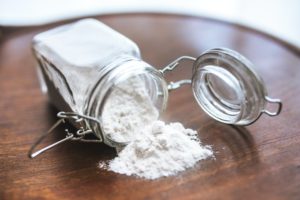
The 1-1-5 Method: Why Every Minute Matters
January 10, 2023
The Golden Key That Unlocks the Mystery Within
April 20, 2023©2023 Wendy Scheuring, The Author’s Writer
One cold, snowy afternoon, when I was a teenager, my grandmother and I were spending some time in the kitchen. She was teaching me how to bake a homemade apple pie. She was showing me how to make the dough when she accidentally added too much water. Even after some substantial kneading, the dough came out quite sticky and unworkable.
“Can we add more flour?” I asked her, thinking that flour would make the dough more workable.

Flour …
“Nope,” she said as she threw the sticky dough into the trash. I was quite surprised to see my grandmother waste anything. She had grown up during the Great Depression and never wasted a thing.
She explained that we would waste even more ingredients if we tried to resurrect that dough because it just was not going to make a good pie crust.
“It’s just better to start over,” she laughed. We washed the bowl and then added the very simple ingredients, flour, salt, and water. That’s all we needed to make a great pliable dough. The ingredients were important, but a good dough was all about the mixing. She never measured her ingredients. She just went by how things looked and how they felt.

and water …
So, what about our own writing? Do we have the right ingredients, and do we know how to mix them property to create out best story or book ever?
We may start with an outline, a recipe, so to speak, the directions for which we will write a book. The outline may be stringent, one we feel we cannot divert from, and yet without the proper mixing, it might not turn out to our liking. It might not be pliable, beautiful, or delicious.

and salt.
The point with an outline is it’s okay to write one in the beginning. But just don’t measure the ingredients. Don’t worry about how many chapters, or how many words each chapter will have.
Also, like Grandma, realize when things are not working, we should be ready to scrap the whole thing, or at least some of it. Otherwise, we may be stuck with sticky dough. Be ready to change up your recipe, the timing, the mixing, etc. Maybe even the ingredients!
Before beginning to write, some writers may feel unsure of themselves so they create a stringent outline by which they feel they must adhere to at all times. (This probably stems from when they were in school, and a teacher required it of them. I must confess that I used to write my papers and then write the outline afterward as it was a requirement that had to be met.) Writing a strict outline never helped me. In fact, the outline used to stop me in my writing tracks. When I just allowed myself to write, the words flowed much more easily on the page. Later on, I could organize my thoughts more easily once I knew what my thought actually were. The act of writing precipitates ideas, especially those that lie within our subconscious that are dying to come to the surface.
So, know the true purpose of an outline, which is to serve as the tentative big picture, or framework, or list of ideas you’d like to include.
Remember that writing is so much more than structure. Baking is much more creative than strictly following a recipe and never being willing to change things up. And, thus, so should writing be.
Obviously, structure makes the writing more easily understood by the reader, but it does not always make it easier for the writer. Writing to a preconceived structure is like coloring in the lines, which can create a pretty, yet boring picture that looks like everyone else’s.
But what happens when you color outside of the lines? You will most likely have a preliminary vision in mind, a framework or scaffold, which can be moved or removed at any time during the writing process. That’s when the fun begins.
Because writing should be fun. Baking is certainly fun.

Don’t forget the ice cream!




